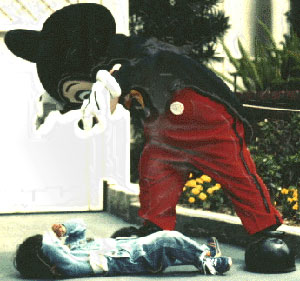Henry Giroux and Grace Pollock
t r u t h o u t
August 10, 2010
 While the “empire of consumption” has been around for a long time[1], American society in the last 30 years has undergone a sea change in the daily lives of children – one marked by a major transition from a culture of innocence and social protection, however imperfect, to a culture of commodification. Youth are now assaulted by a never-ending proliferation of marketing strategies that colonize their consciousness and daily lives. Under the tutelage of Disney and other megacorporations, children have become an audience captive not only to traditional forms of media such as film, television and print, but even more so to the new digital media made readily accessible through mobile phones, PDAs, laptop computers and the Internet. The information, entertainment and cultural pedagogy disseminated by massive multimedia corporations have become central in shaping and influencing every waking moment of children’s daily lives – all toward a lifetime of constant, unthinking consumption. Consumer culture in the United States and increasingly across the globe, does more than undermine the ideals of a secure and happy childhood: it exhibits the bad faith of a society in which, for children, “there can be only one kind of value, market value; one kind of success, profit; one kind of existence, commodities; and one kind of social relationship, markets.”[2] But corporate-controlled culture not only exploits and distorts the hopes and desires of individuals: it is fundamentally driven toward exploiting public goods for private gain, if it does not also more boldly seek to privatize everything in the public realm. Among US multimedia megacorporations, Disney appears one of the least daunted in attempting to dominate public discourse and undermine the critical and political capacities necessary for the next generation of young people to sustain even the most basic institutions of democracy.
While the “empire of consumption” has been around for a long time[1], American society in the last 30 years has undergone a sea change in the daily lives of children – one marked by a major transition from a culture of innocence and social protection, however imperfect, to a culture of commodification. Youth are now assaulted by a never-ending proliferation of marketing strategies that colonize their consciousness and daily lives. Under the tutelage of Disney and other megacorporations, children have become an audience captive not only to traditional forms of media such as film, television and print, but even more so to the new digital media made readily accessible through mobile phones, PDAs, laptop computers and the Internet. The information, entertainment and cultural pedagogy disseminated by massive multimedia corporations have become central in shaping and influencing every waking moment of children’s daily lives – all toward a lifetime of constant, unthinking consumption. Consumer culture in the United States and increasingly across the globe, does more than undermine the ideals of a secure and happy childhood: it exhibits the bad faith of a society in which, for children, “there can be only one kind of value, market value; one kind of success, profit; one kind of existence, commodities; and one kind of social relationship, markets.”[2] But corporate-controlled culture not only exploits and distorts the hopes and desires of individuals: it is fundamentally driven toward exploiting public goods for private gain, if it does not also more boldly seek to privatize everything in the public realm. Among US multimedia megacorporations, Disney appears one of the least daunted in attempting to dominate public discourse and undermine the critical and political capacities necessary for the next generation of young people to sustain even the most basic institutions of democracy.
Fresh food that lasts from eFoods Direct
- A d v e r t i s e m e n t
- {openx:49}
The impact of new electronic technologies as teaching machines can be seen in some rather astounding statistics. It is estimated that the average American spends more than six hours a day watching video-based entertainment and, by 2013, the numbers of daily hours spent watching television and videos will match the numbers of hours spent sleeping.[3] The American Medical Association reports that the combined hours “spent in front of a television or video screen is the single biggest chunk of time in the waking life of an American child.”[4] Such statistics warrant grave concern, given that the messages provided through such programming are shaped largely by a $263-billion-dollar-a-year US advertising industry[5], which sells not only its products, but also values, images and identities largely aimed at teaching young people to be consumers. A virtual army of marketers, psychologists and corporate executives are currently engaged in what Susan Linn calls a “hostile takeover of childhood,”[6] seeking in the new media environment to take advantage of the growing economic power wielded by children and teens. Figures on direct spending by young people have dramatically increased in the last ten years to the point where it is now estimated that each year pre-teens and teenagers marshal “$200 billion in spending power.”[7] And this is not all. Young people also exert a powerful influence on parental spending, offering up a market in which, according to Anap Shah, “Children (under 12) and teens influence parental purchases totaling over … $670 billion a year.”[8] Because of their value as consumers and their ability to influence spending, young people have become major targets of an advertising and marketing industry that spends over $17 billion a year on shaping children’s identities and desires.[9]
The Emergency Election Sale is now live! Get 30% to 60% off our most popular products today!


